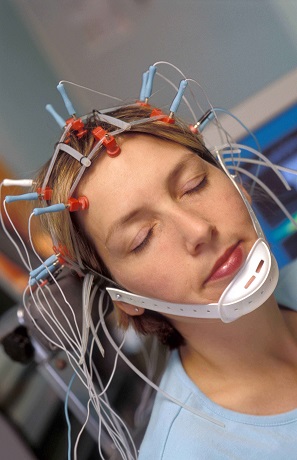Chapter 53. Stages of Sleep
Learning Objectives

Identify the stages of the sleep cycle as indicated by EEG waves.
Describe the general relationship between the shape of the EEG waves and the depth of sleep.
Review
Review
Select the NEXT button to continue with the Review.

1. You will spend about one-third of your life asleep. Have you ever wondered what your brain is doing while you are sleeping?
Review
Review
Select the NEXT button to continue with the Review.

2. In the mid-1900s, researchers discovered that the brain gives off weak electrical signals generated by the simultaneous firing of millions of neurons. Electrodes placed on the scalp can detect these signals, which provide a graphic record—an electroencephalogram (EEG)—of the overall activity of the brain.
Review
Review
Select the NEXT button to continue with the Review.

3. When sleep researchers examined the EEG brain waves across an entire night’s sleep, they found a clear pattern: Slower waves are associated with greater relaxation and deeper sleep.
Review
Review
Select the NEXT button to continue with the Review.

4. Brain activity gradually slows as a person drifts off to sleep, then gets steadily slower and more regular over the next half-hour or so, as the person moves through three stages—from light sleep to deep sleep—called NREM-1, NREM-2, and NREM-3. This pattern then reverses, and the person moves from deep sleep into lighter sleep.
Review
Review
Select the NEXT button to continue with the Review.

5. Instead of returning to NREM-1, the sleeper goes into a very different stage called REM sleep, accompanied by "jerky" eye movements, small, fast EEG waves, and vivid dreams. During REM sleep, the brain is highly active, but the body (except for the eyes) is almost completely paralyzed.
Review
Review
Select the NEXT button to continue with the Review.

6. The full sequence (dipping into deeper sleep, and then lighter sleep followed by REM sleep) is called the sleep cycle, and is repeated 3 to 5 times in a typical night. Notice that most of the deep sleep (NREM-3) occurs in the first half of sleep, while more REM sleep occurs in the last few hours.
Practice 1: Exploring the Sleep Stages
Practice 1: Exploring the Sleep Stages
Select each EEG brainwave to view a brief description of the associated stage of sleep.
NREM-1: stage of light sleep without rapid eye movements, characterized by relatively small and irregular EEG waves
NREM-2: stage between light sleep and deep sleep, characterized by medium-size EEG waves without rapid eye movements, and occasional bursts of high activity called sleep spindles
NREM-3: stage of deep sleep without rapid eye movements, characterized by large, slow EEG waves
REM: stage of sleep characterized by rapid eye movements and small, irregular EEG waves; most dreams occur during this stage

Practice 2: Observing the Sleep Stages
Practice 2: Observing the Sleep Stages
Select the PLAY button to view the sequence of stages in the sleep cycle across an entire night.
In a typical night, you pass through each of these stages of sleep several times in a regular pattern called the sleep cycle.
During which half of the night do you experience the most slow-wave, deep sleep (NREM-3)? During which half of the night do you experience the most REM sleep?
Quiz 1
Quiz 1
Drag each sleep stage label to its EEG wave. When all the labels have been placed, select the CHECK ANSWER button.




Quiz 2
Quiz 2
Match the sleep stages to their descriptions by dragging each colored circle to the appropriate gray circle. When all the circles have been placed, select the CHECK ANSWER button.
Conclusion
